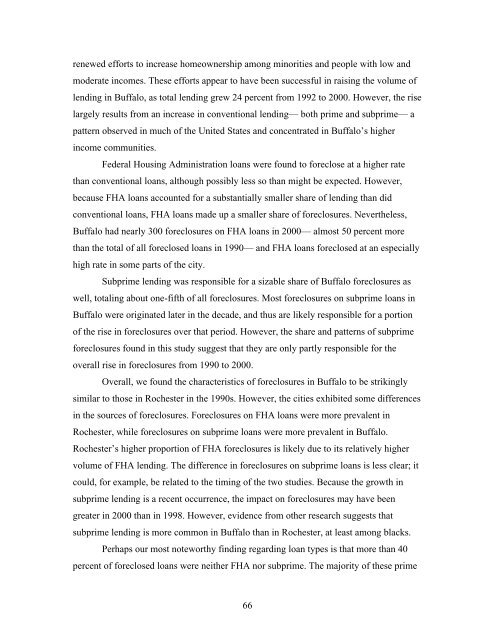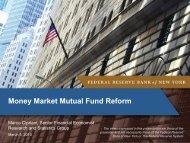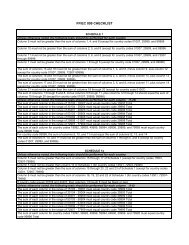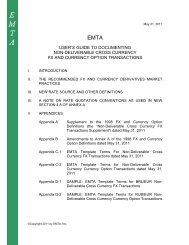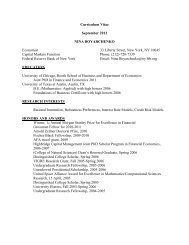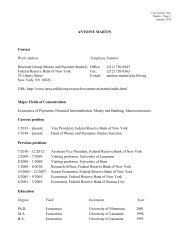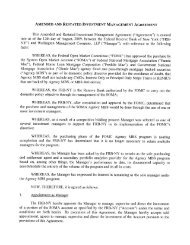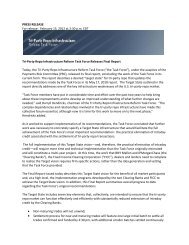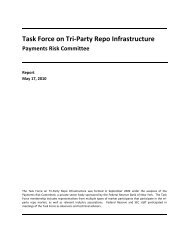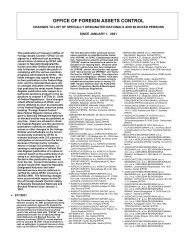Residential Foreclosures in the City of Buffalo, 1990-2000 - Federal ...
Residential Foreclosures in the City of Buffalo, 1990-2000 - Federal ...
Residential Foreclosures in the City of Buffalo, 1990-2000 - Federal ...
You also want an ePaper? Increase the reach of your titles
YUMPU automatically turns print PDFs into web optimized ePapers that Google loves.
enewed efforts to <strong>in</strong>crease homeownership among m<strong>in</strong>orities and people with low and<br />
moderate <strong>in</strong>comes. These efforts appear to have been successful <strong>in</strong> rais<strong>in</strong>g <strong>the</strong> volume <strong>of</strong><br />
lend<strong>in</strong>g <strong>in</strong> <strong>Buffalo</strong>, as total lend<strong>in</strong>g grew 24 percent from 1992 to <strong>2000</strong>. However, <strong>the</strong> rise<br />
largely results from an <strong>in</strong>crease <strong>in</strong> conventional lend<strong>in</strong>g— both prime and subprime— a<br />
pattern observed <strong>in</strong> much <strong>of</strong> <strong>the</strong> United States and concentrated <strong>in</strong> <strong>Buffalo</strong>’s higher<br />
<strong>in</strong>come communities.<br />
<strong>Federal</strong> Hous<strong>in</strong>g Adm<strong>in</strong>istration loans were found to foreclose at a higher rate<br />
than conventional loans, although possibly less so than might be expected. However,<br />
because FHA loans accounted for a substantially smaller share <strong>of</strong> lend<strong>in</strong>g than did<br />
conventional loans, FHA loans made up a smaller share <strong>of</strong> foreclosures. Never<strong>the</strong>less,<br />
<strong>Buffalo</strong> had nearly 300 foreclosures on FHA loans <strong>in</strong> <strong>2000</strong>— almost 50 percent more<br />
than <strong>the</strong> total <strong>of</strong> all foreclosed loans <strong>in</strong> <strong>1990</strong>— and FHA loans foreclosed at an especially<br />
high rate <strong>in</strong> some parts <strong>of</strong> <strong>the</strong> city.<br />
Subprime lend<strong>in</strong>g was responsible for a sizable share <strong>of</strong> <strong>Buffalo</strong> foreclosures as<br />
well, total<strong>in</strong>g about one-fifth <strong>of</strong> all foreclosures. Most foreclosures on subprime loans <strong>in</strong><br />
<strong>Buffalo</strong> were orig<strong>in</strong>ated later <strong>in</strong> <strong>the</strong> decade, and thus are likely responsible for a portion<br />
<strong>of</strong> <strong>the</strong> rise <strong>in</strong> foreclosures over that period. However, <strong>the</strong> share and patterns <strong>of</strong> subprime<br />
foreclosures found <strong>in</strong> this study suggest that <strong>the</strong>y are only partly responsible for <strong>the</strong><br />
overall rise <strong>in</strong> foreclosures from <strong>1990</strong> to <strong>2000</strong>.<br />
Overall, we found <strong>the</strong> characteristics <strong>of</strong> foreclosures <strong>in</strong> <strong>Buffalo</strong> to be strik<strong>in</strong>gly<br />
similar to those <strong>in</strong> Rochester <strong>in</strong> <strong>the</strong> <strong>1990</strong>s. However, <strong>the</strong> cities exhibited some differences<br />
<strong>in</strong> <strong>the</strong> sources <strong>of</strong> foreclosures. <strong>Foreclosures</strong> on FHA loans were more prevalent <strong>in</strong><br />
Rochester, while foreclosures on subprime loans were more prevalent <strong>in</strong> <strong>Buffalo</strong>.<br />
Rochester’s higher proportion <strong>of</strong> FHA foreclosures is likely due to its relatively higher<br />
volume <strong>of</strong> FHA lend<strong>in</strong>g. The difference <strong>in</strong> foreclosures on subprime loans is less clear; it<br />
could, for example, be related to <strong>the</strong> tim<strong>in</strong>g <strong>of</strong> <strong>the</strong> two studies. Because <strong>the</strong> growth <strong>in</strong><br />
subprime lend<strong>in</strong>g is a recent occurrence, <strong>the</strong> impact on foreclosures may have been<br />
greater <strong>in</strong> <strong>2000</strong> than <strong>in</strong> 1998. However, evidence from o<strong>the</strong>r research suggests that<br />
subprime lend<strong>in</strong>g is more common <strong>in</strong> <strong>Buffalo</strong> than <strong>in</strong> Rochester, at least among blacks.<br />
Perhaps our most noteworthy f<strong>in</strong>d<strong>in</strong>g regard<strong>in</strong>g loan types is that more than 40<br />
percent <strong>of</strong> foreclosed loans were nei<strong>the</strong>r FHA nor subprime. The majority <strong>of</strong> <strong>the</strong>se prime<br />
66


